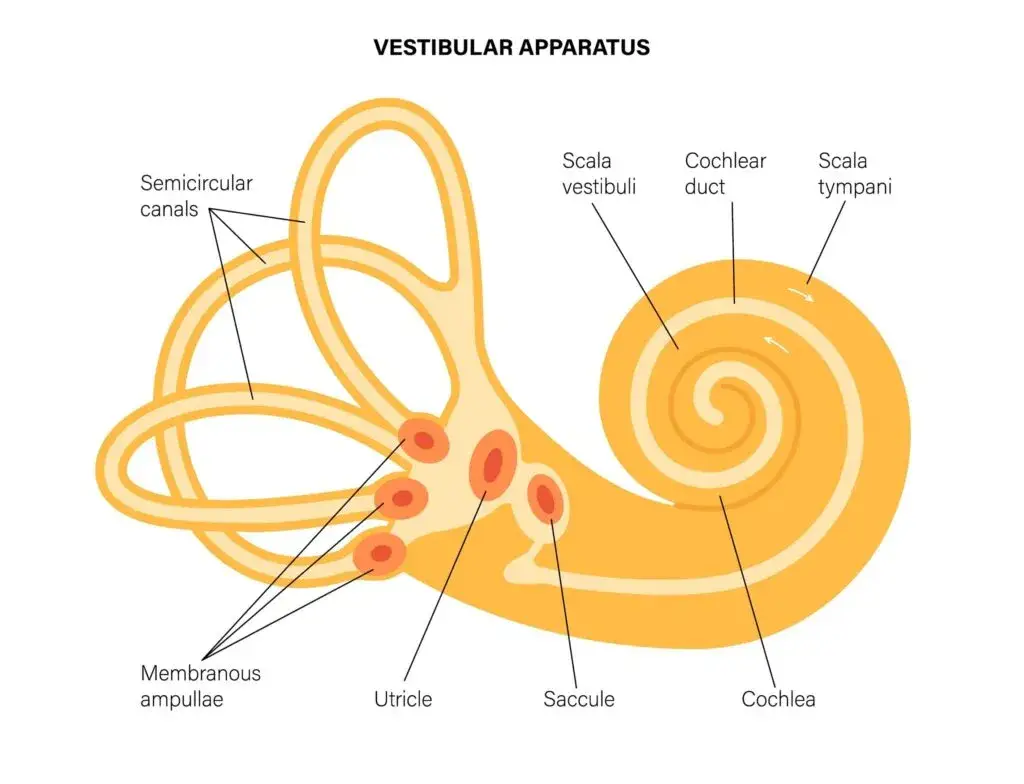
Why Vertigo Happens: If you’ve ever felt like the room was spinning, like your body was floating on a boat you can’t see, or like you were tipping to one side even while standing still, you know how disruptive vertigo can be. For many people in Sarasota, Lakewood Ranch, and Bradenton, vertigo isn’t just an occasional annoyance—it’s a daily barrier to driving, working, caring for family, and enjoying life in our beautiful corner of Southwest Florida. The good news? Vertigo has causes we can understand and address. And one of the most overlooked—but highly impactful—contributors is misalignment in the upper neck (the atlas and axis).
In this in-depth guide, we’ll explain what vertigo is, review common symptoms, unpack the science of how the upper cervical spine influences your balance system, and show how the specialized, gentle approach at Lavender Family Chiropractic helps get to the root cause with upper cervical chiropractic care. We’ll also include practical tips, patient stories, and a top 15 FAQs section to answer the questions we hear most often.
Whether you searched “vertigo doctor near me,” “upper cervical chiropractor near me,” or “chiropractor Sarasota Florida,” you’re in the right place. Let’s demystify vertigo and map a clear path forward—one that aims to restore balance from the inside out.
Why Vertigo Happens: What Is Vertigo?
Vertigo is the false sensation of movement—you feel like you or your surroundings are spinning, rocking, swaying, or tilting when nothing is actually moving. Vertigo is a symptom, not a diagnosis. It’s the body’s way of saying your internal orientation system—made up of your inner ears (vestibular system), eyes (visual system), and upper neck/body sensors (proprioceptive system)—isn’t integrating information smoothly.
When these three systems agree, you feel grounded and steady. When they disagree, your brain interprets the mismatch as motion—and you feel dizzy or unsteady. That’s the essence of vertigo: sensory conflict. The key to lasting relief is not only calming acute symptoms but also reducing the mismatches that keep triggering them.
Symptoms of Vertigo (Beyond “The Spins”)
Vertigo can look different from one person to the next. You may experience one or many of the symptoms below, and they may be constant, come in waves, or flare with certain triggers such as weather changes, quick head turns, or stress.
- Spinning, tilting, or rocking sensations
- Unsteadiness or feeling “pulled” to one side
- Nausea or vomiting
- Headaches or pressure, often around the temples, crown, or base of the skull
- Ear fullness, popping, crackling, or pressure changes
- Ringing (tinnitus) or sound sensitivity
- Neck tightness or pain, especially under the skull
- Visual sensitivity, light sensitivity, or “visual vertigo” in busy stores
- Brain fog, difficulty concentrating, or motion sensitivity
- Anxiety, especially connected to fear of a flare in public or while driving
Because vertigo overlaps with so many systems (ear, eye, neck, and nervous system), it’s common to get partial answers—“It’s just BPPV,” or “It’s just sinus pressure”—without addressing the full picture. That’s why a whole-person assessment, including the upper cervical spine, is so important.
How Vertigo Is Commonly Diagnosed—and Why People Get Stuck
Many people first encounter vertigo during a sudden, dramatic episode: the room spins, you grab a wall, and everything feels off for hours or days. You may undergo tests (like hearing exams, eye movement tests, or imaging). You might be given medications to calm nausea or dizziness. If ear crystals (otoconia) are suspected, you may try positional maneuvers. These steps can be useful, but they often stop short of exploring the upper neck, even though it fundamentally shapes balance input to your brain.
Here’s where people get stuck:
- Symptom management without system coordination. Medications can reduce the intensity of an episode but don’t necessarily re-synchronize the systems causing the mismatch.
- Ear-only focus. Inner ear tests are valuable, yet many folks have normal ear findings while still feeling dizzy. That gap is often cervical (neck) and neurologic.
- Neck overlooked because it’s subtle. Neck misalignment can be tiny—millimeters—but still disrupt proprioception, change head/ear orientation, and irritate key neural pathways around the brainstem.
When vertigo keeps returning, it’s a strong hint that your integration systems aren’t in harmony. The upper cervical spine is a critical player in restoring that harmony.
The Upper Neck’s Role in Balance: Your Hidden Gyroscope
Imagine your balance system as a three-way conversation:
- Vestibular system (inner ear): Senses head movement and position relative to gravity.
- Visual system (eyes): Anchors you to the horizon and your environment.
- Proprioceptive system (neck & body sensors): Reports joint position, muscle tension, and alignment—especially in the upper neck, which sits closest to the brainstem.
The atlas (C1) and axis (C2) vertebrae cradle the base of your skull and surround the delicate neurologic structures that coordinate balance and posture. Nerve pathways in this region interact with the vestibular nuclei, oculomotor centers (eye tracking), and cervical proprioceptive networks. When the atlas/axis are misaligned, several things may happen:
- Proprioceptive Mismatch: Altered joint mechanics and muscle tone (especially suboccipital muscles) send noisy or distorted data about head position. Your brain receives one story from the neck, another from the ears, and a third from the eyes—mismatch equals dizziness.
- Reflex Disruption: Head-neck integration involves reflexes (like the vestibulo-ocular reflex) that stabilize your gaze when you move. Misalignment can destabilize that coordination, producing blurry vision, motion sensitivity, or “lag” between head movement and visual clarity.
- Autonomic Irritation: The area near the brainstem helps regulate autonomic balance (sympathetic/parasympathetic). Irritation or stress responses related to upper cervical dysfunction can heighten light/sound sensitivity, nausea, and anxiety—amplifying vertigo.
- Eustachian Tube & Drainage Mechanics: Postural strain can change temporal bone dynamics and neck muscle tension, contributing to ear pressure and poor drainage that make you feel “full,” off-balance, or “under water.”
- Circulatory/Fluid Dynamics: While we avoid over-claiming, improved head-neck alignment is associated with more efficient mechanics that may aid normal fluid movement around the head and neck. Many patients report less “pressure” and clearer headspace when alignment is restored.
In short, the upper neck is your hidden gyroscope. When it’s off, the whole system wobbles.
Why Misalignment in the Upper Neck Can Trigger Vertigo
1) Proprioceptive Overload and “Motion Lies”
Your brain constantly merges signals from the ears, eyes, and neck. If the atlas has shifted, your deep neck muscles can become hypertonic on one side and inhibited on the other. That subtle imbalance feeds wrong position data into your brain, like a GPS with poor satellite lock. The result? Your brain interprets normal movements as abnormal, creating a motion illusion—vertigo.
2) Sensitization of the Brainstem Region
Upper cervical dysfunction can contribute to sensitization around the trigeminocervical complex—a nerve hub that links neck sensation, head pain, and autonomic responses. When this region is irritated, people often develop headaches, nausea, light sensitivity, and dizziness, especially during neck movement or visual stimulation. Restoring alignment can reduce the input “noise” to this hub.
3) Eye-Neck Coordination and Visual Vertigo
If neck proprioception is off, your brain struggles to predict how your eyes should stabilize during head movement. That can produce visual lag, a sense that the world “bounces,” or the disorienting feeling in stores with busy patterns. Correcting the atlas/axis helps recalibrate eye-neck timing, which often improves visual tolerance.
4) Ear Pressure, Eustachian Tube Behavior, and Weather Sensitivity
Patients with upper cervical misalignment frequently report ear fullness, popping, or fluttering that worsens with barometric pressure changes. Tension in the neck, jaw, and upper throat region can alter the way the Eustachian tube opens and drains. By normalizing head-neck posture and muscular tone, many patients notice their ear pressure stabilizes, reducing weather-triggered dizziness.
5) Autonomic Balance and Nausea
Motion sickness and vertigo often come with autonomic symptoms: queasy stomach, clammy hands, heart-pounding moments. The upper cervical area influences autonomic tone. Precise, gentle corrections—not forceful twisting—can help the body move toward parasympathetic calm, easing the nausea that so often accompanies vertigo.
Types of Vertigo—and Where the Upper Neck Fits
Vertigo isn’t one thing. Different patterns point to different origins. Here’s how the upper cervical spine can be relevant across common categories:
Benign Paroxysmal Positional Vertigo (BPPV)
- What it is: Ear crystals (otoconia) shift into a semicircular canal, causing spinning with certain head positions (rolling in bed, looking up).
- Classic sign: Brief, position-triggered spins; often positive Dix-Hallpike test.
- Upper cervical connection: Even after successful canalith maneuvers, some people still feel “off.” The reason can be a lingering neck-driven mismatch. Optimizing atlas/axis alignment improves baseline proprioception, reducing re-triggers and improving overall stability.
Vestibular Migraine
- What it is: Migraine pathways impact balance centers, causing episodes of dizziness with or without headache.
- Common signs: Motion sensitivity, visual triggers, brain fog, sound/light sensitivity; may or may not have head pain.
- Upper cervical connection: The trigeminocervical network integrates neck input with headache pathways. When the upper neck is misaligned, it can sensitize this network, feeding the migraine-dizziness cycle. Gentle upper cervical care helps de-sensitize neck inputs and often reduces frequency/intensity of dizzy episodes.
Ménière’s-Type Patterns (Fluctuating Ear Symptoms)
- What it is: Episodes of vertigo with ear fullness, fluctuating hearing, and tinnitus.
- Upper cervical connection: While true Ménière’s is complex, many patients with ear pressure and vertigo also have upper neck imbalance. Improving alignment may help stabilize ear pressure mechanics, reduce strain patterns, and make other medical strategies work better.
Vestibular Neuritis/Labyrinthitis (Post-Viral Dizziness)
- What it is: An inflammatory event can leave one ear weaker. You may test “asymmetric” on vestibular exams and feel unsteady for months.
- Upper cervical connection: During recovery, the brain relies on clear, reliable neck input to compensate for the weaker ear. If the neck is misaligned, compensation is slower and symptoms linger. Upper cervical care helps the brain re-weight inputs efficiently.
Mal de Débarquement-Like Symptoms (MdDS)
- What it is: Rocking/swaying sensation after boats, flights, or long car rides.
- Upper cervical connection: Persistent motion can “tune” your balance system into the wrong baseline. Correcting neck proprioception provides a new stable reference so your brain can “retune” back to stillness.
Cervicogenic Dizziness
- What it is: Dizziness primarily driven by neck dysfunction.
- Clues: Worse with neck movement, neck pain, tight suboccipitals, relief after posture correction or gentle neck work.
- Upper cervical connection: This is the bullseye for atlas/axis care—restore alignment, calm irritated tissues, and improve proprioception to reduce dizziness.
PPPD (Persistent Postural-Perceptual Dizziness)
- What it is: Chronic non-spinning dizziness with visual motion sensitivity and anxiety overlay.
- Upper cervical connection: While PPPD needs a holistic plan, normalizing neck input can reduce the constant “uncertain” signal, which lowers the system’s threat level and improves tolerance to daily environments.
Lavender Family Chiropractic: Getting to the Root with Upper Cervical Care
At Lavender Family Chiropractic in Sarasota (serving Bradenton, Lakewood Ranch, Parrish, Ellenton, Venice, Osprey, Punta Gorda, St. Petersburg, Siesta Key, Longboat Key, Lido Key, and Myakka City), we focus on the upper cervical spine because it’s the control center for posture and balance. Our three-doctor team—Dr. Rusty Lavender, Dr. Jacob Temple, and Dr. Will Guzinski—uses a precise, gentle approach to correct misalignments without popping, twisting, or cracking.
Here’s how we get to the root:
1) 3D CBCT Imaging for the Atlas/Axis
We utilize state-of-the-art 3D CBCT scanning to see the exact orientation of your atlas and axis in three dimensions. This level of detail helps us plan a correction that’s personalized to you, not a generic adjustment.
2) Functional Nervous System Scans (Tytron)
We use paraspinal infrared thermography (Tytron) to assess autonomic patterns and track changes over time. It’s a non-invasive way to monitor how your nervous system responds as alignment improves.
3) Gentle, Precise Upper Cervical Adjustments
Our knee-chest upper cervical technique uses light, exact vectors calibrated to your measurements. Most patients are surprised by how gentle the correction feels—and how profoundly steady they feel afterward.
4) Stabilization Phase
After the correction, we support stability with tailored strategies: rest protocols, ergonomic coaching, simple home exercises, and pacing for visual/vestibular exposures. The goal is to help your brain lock in the new, correct map of where your head and neck are in space.
5) Progress Tracking
You’ll know how you’re doing—not just subjectively, but through objective scans, posture checks, and re-imaging when appropriate. Steady objective improvement tends to correlate with fewer flare-ups and more confident movement.
Patients often tell us, “I still have a trigger here or there, but I recover faster and I’m less scared of my symptoms.” That shift—from fragile to resilient—is one of the biggest wins with upper cervical care.
What to Expect on Your First Visit
- Conversation & History: We listen. We want to understand your full story—onset, patterns, triggers, prior evaluations, and goals (driving, working out, traveling again).
- Examination: We evaluate posture, range of motion, neurologic signs, balance tests, and targeted vestibular screens when appropriate.
- 3D CBCT Scan: If indicated, we’ll take a precise, low-dose 3D CBCT scan of your upper neck to see misalignment details you can’t see on standard X-rays.
- Personalized Plan: If your case is a fit for upper cervical care, we’ll outline a step-by-step plan: correction strategy, stabilization schedule, and expectations for recovery.
- First Correction (If Appropriate): The adjustment is gentle and specific, often followed by a brief rest period to let your body integrate.
Many people notice immediate changes in head pressure, ear fullness, or steadiness. Others need a series of corrections and stabilization visits as the body re-maps. Both paths are normal; your plan is tailored to you.
Real-World Stories (Names Changed for Privacy)
- “Samantha,” 42, Teacher: Years of “rocking” dizziness, worse in big stores. Ear tests normal. After atlas correction and stabilization, she reported “the floor feels still again” and could shop without holding the cart. Occasional visual triggers remained, but episodes were shorter and milder.
- “Mark,” 55, Contractor: Rolling-in-bed spins diagnosed as BPPV. Maneuvers helped, but weekly “off days” persisted. CBCT showed a pronounced C1 tilt. After a series of gentle corrections and posture coaching, he went from two bad days/week to two per month, most lasting under 30 minutes.
- “Ava,” 29, Runner: Vestibular migraine with nausea and light sensitivity. Neck tightness under the skull. With upper cervical care plus hydration/sleep hygiene, she cut dizzy days by 70% and resumed morning runs.
Every case is unique, but the pattern is clear: when you optimize head-neck alignment, the balance system finds its steady state more easily.
Your Home Support Toolkit (That Pairs Well with Upper Cervical Care)
- Hydration & Minerals: Consistent hydration can help your system tolerate movement and heat better.
- Gentle Neck Mobility (When Appropriate): After alignment is stabilized, simple mobility drills or a guided home program may help maintain comfort.
- Pacing & Exposure: Gradually reintroduce visually busy environments; use sunglasses or hats if light is a trigger during the transition.
- Sleep & Pillow Fit: A neutral, supportive pillow (not too high, not too flat) keeps the atlas/axis happy overnight.
- Stress Regulation: Breathwork, short walks, and realistic pacing keep the autonomic system from spiraling—even on “off” days.
(Always follow the plan your doctor provides; these tips complement personalized care and do not replace medical guidance.)
Top 15 FAQs About Vertigo and Upper Cervical Care
1) Is upper cervical chiropractic safe for vertigo?
Yes. Our approach is gentle and precise, avoiding twisting or forceful manipulation. We use 3D CBCT imaging to plan your correction, then re-evaluate to ensure your body is responding well. Safety and specificity are our top priorities.
2) How quickly will I feel better?
Some feel steadier immediately; others improve over weeks as the nervous system recalibrates. Vertigo often improves in stages—shorter episodes, fewer triggers, then stronger confidence.
3) What if my ENT or neurologist said my ears/brain look normal?
That’s common. Balance requires integration between ears, eyes, and neck. If ear and brain tests are normal, the missing piece may be upper neck alignment and proprioception.
4) Can this help vestibular migraine?
We see many people with vestibular migraine find relief when the trigeminocervical region is less irritated. While no single therapy is a cure-all, upper cervical care often reduces frequency and intensity, especially alongside healthy routines.
5) Do you treat BPPV?
We evaluate for BPPV and refer for appropriate canalith maneuvers if needed. Many patients benefit from upper cervical care after maneuvers to stabilize the system and lower relapse risk.
6) What makes Lavender Family Chiropractic different?
Our 3-doctor team (Dr. Rusty Lavender, Dr. Jacob Temple, Dr. Will Guzinski) focuses on upper cervical only, uses 3D CBCT and Tytron scanning, and delivers adjustments that are gentle, measured, and personalized.
7) Will I need long-term care?
We aim for stability, not endless adjustments. Early on, visits are closer together as we establish alignment; then we space out as you hold corrections longer. Our goal is durable change.
8) Can upper cervical care help ear fullness and pressure?
Many patients report improved ear pressure as posture and muscular tone normalize around the head and neck. Results vary, but reduced fullness is a frequent early win.
9) Is this just about posture?
Posture matters, but we’re targeting neurologic integration—how your brain processes signals from the neck, eyes, and ears. Alignment changes posture and the quality of input to your brain.
10) Do you work with my other providers?
Absolutely. We collaborate with ENTs, neurologists, physical therapists, and primary care providers. Vertigo is best treated as a team sport.
11) What if my imaging elsewhere was “normal”?
Standard films often don’t visualize the atlas/axis in three dimensions. Our 3D CBCT captures nuances that routine X-rays can miss, guiding a more precise plan.
12) Will I have to change my activities?
In the beginning, we may pace certain triggers while your system recalibrates. As you stabilize, the goal is a full return to the activities you love—driving, working out, being on the water.
13) Do you take insurance?
Our office is out of network with insurance. Many of our patients receive a superbill to submit to their insurance for reimbursement based on their coverage. We offer many different payment options as well as finance options.
14) How do I know if my vertigo is from my neck?
Clues include neck tightness, symptoms with head/neck movement, or relief after gentle traction or postural changes. A thorough upper cervical evaluation is the best next step.
15) What results can I realistically expect?
Most patients report steadier days, fewer triggers, and faster recovery from flare-ups. Some achieve full resolution; others see major improvements that make life predictable again. We’ll set clear goals and measure progress together.
Why Choose a Local Expert in Sarasota–Bradenton–Lakewood Ranch
If you’re searching for “chiropractor near me,” “upper cervical chiropractor near me,” or a trusted vertigo doctor near me in the Sarasota area, you want a team that blends precision technology with compassionate care. At Lavender Family Chiropractic, we’ve built our clinic around that promise:
- 3D CBCT imaging to see what others may miss
- Tytron functional nervous system scans to track objective change
- Gentle, precise corrections—no twisting, popping, or cracking
- A 3-doctor team focused on upper cervical outcomes
- A warm, encouraging atmosphere where your story matters
We serve Sarasota, Bradenton, Lakewood Ranch, Parrish, Ellenton, Venice, Osprey, Punta Gorda, St. Petersburg, Siesta Key, Longboat Key, Lido Key, and Myakka City—and we’re honored to be recognized by our community as a leading destination for upper cervical chiropractic and vertigo care.
Your Next Step: Let’s Steady the Ground Again
You don’t have to tiptoe through life, fearing the next spin. If your gut tells you that something in your neck is contributing to your dizziness—or if you’ve tried medication or maneuvers and still don’t feel steady—it’s time to explore the upper cervical piece of your puzzle.
Lavender Family Chiropractic in Sarasota Florida offers complimentary consultations to learn more about you. Click the link below!
https://intake.chirohd.com/new-patient-scheduling/724/lavender-family-chiropractic
Visit our Website!
To learn more about us go to http://www.chiropractorsarasotaflorida.com
We also service Bradenton, Parrish, Ellenton, Ruskin, Venice, Tampa, St. Pete, Osprey, Longboat, Lakewood Ranch, Myakka City.
If you are in Tampa, Fort Myers, or Salt Lake City, you can visit my other locations! NeckWise Upper Cervical. Visit, www.neckwise.com
If you are not local, visit www.uccnearme.com to find a doctor in your area.
- Visit www.chiropractorsarasotaflorida.com
- Call (941) 243-3729 to schedule your consultation
- Ask about a comprehensive upper cervical evaluation with 3D CBCT and Tytron scanning
At Lavender Family Chiropractic, our mission is simple: help your body find its balance again—gently, precisely, and with encouragement at every step. With the right plan and the right team, the ground can feel steady beneath your feet.
Quick Recap
- Vertigo is often a mismatch between ears, eyes, and neck sensors.
- The upper cervical spine (atlas/axis) profoundly influences balance and orientation.
- Misalignment can distort proprioception, irritate the trigeminocervical region, alter Eustachian tube mechanics, and amplify autonomic symptoms—fueling dizziness.
- Lavender Family Chiropractic uses 3D CBCT, Tytron scans, and gentle, precise corrections to help re-synchronize your balance systems.
- Our Sarasota-area team (Dr. Rusty Lavender, Dr. Jacob Temple, Dr. Will Guzinski) is here to guide you toward lasting stability.
If you’re ready for answers—and a plan that respects both the science and your story—we’re here to help.





